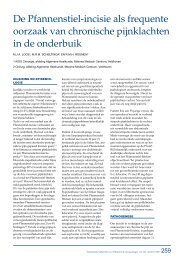Surgical management of chronic inguinal pain syndromes - Liespijn
Surgical management of chronic inguinal pain syndromes - Liespijn
Surgical management of chronic inguinal pain syndromes - Liespijn
Create successful ePaper yourself
Turn your PDF publications into a flip-book with our unique Google optimized e-Paper software.
damage, dysfunction <strong>of</strong> periurethral structures involved in ejaculation, or encasement<strong>of</strong> the spermatic cord caused by mesh or scar tissue. This is supported by anecdotalreports on patients with dysejaculation in which dissection <strong>of</strong> twisted fibrotic spermaticcords combined with an ilio<strong>inguinal</strong> neurectomy provided total <strong>pain</strong> relief 14 . Due to itshigh incidence and the scarce literature, more research on etiology and treatment <strong>of</strong>dysejaculatory complaints after <strong>inguinal</strong> hernioplasty is recommended.Over thirty per cent <strong>of</strong> all postherniorrhaphy <strong>pain</strong> patients reported to suffer from other<strong>chronic</strong> <strong>pain</strong> <strong>syndromes</strong> as well. A correlation between the onset <strong>of</strong> postherniorrhaphy<strong>pain</strong> and other <strong>pain</strong> <strong>syndromes</strong> has been previously described in hernia literature andmay be due to genetic and psychosocial factors 13 . Patients with a tendency to develop<strong>chronic</strong> <strong>pain</strong> are more susceptible to develop additional <strong>pain</strong> <strong>syndromes</strong> as well.Classifying postherniorrhaphy <strong>pain</strong> <strong>syndromes</strong> may allow for tailored treatmentregimens. The first step in a protocol for treatment <strong>of</strong> postherniorrhaphy neuralgiadescribed by Lichtenstein nearly two decades ago consisted <strong>of</strong> primary diagnosis andtreatment by injections 16 . Surprisingly, in the present study a single diagnostic nerveblock with Lidocain led to a long-term (>1 month) <strong>pain</strong> reduction in twenty-five percent<strong>of</strong> our patients, confirming the therapeutic potential <strong>of</strong> such injections. Althoughrecognized, the phenomenon <strong>of</strong> permanent or long-term cure following injection <strong>of</strong>short acting anaesthetics is not well understood 15 . If (repeated) injection therapy fails,the second step might be an operative transsection 16 . Later on it was suggested by Amidthat transsection should include all three groin nerves (‘triple neurectomy’) 12 . Because<strong>of</strong> central and peripheral communication and possible involvement <strong>of</strong> all three nerves,a maximal length <strong>of</strong> ilio<strong>inguinal</strong>, iliohypogastric and genit<strong>of</strong>emoral in both directionsshould be transsected and removed.Reports on the effect <strong>of</strong> mesh on nerves and <strong>chronic</strong> <strong>pain</strong> are scarce. According to arecent animal study, inserted mesh may lead to an inflammatory and fibroblasticresponse resulting in adhesions and mechanical entrapment <strong>of</strong> adjacent nerve fibresand structures such as the spermatic cord 17 . Whether these mesh-related nerve changesare responsible for any <strong>pain</strong> sensation is unknown. One study comparing mesh withsuturing techniques using the body’s own tissue showed similar incidence rates <strong>of</strong><strong>chronic</strong> <strong>pain</strong> 11 . Nevertheless, removal <strong>of</strong> mesh in combination with a neurectomyappeared to be successful in 60% <strong>of</strong> patients with <strong>chronic</strong> inguinodynia 18 . Apart <strong>of</strong> itsinflammatory potential, implanted mesh may also exert mechanical pressure onneighbouring structures or may fold or wrinkle (‘meshoma’) causing <strong>chronic</strong> <strong>pain</strong> 19 . A(partial) removal <strong>of</strong> mesh in combination with a (triple) neurectomy may be consideredthe preferred treatment in patients with severe neuropathic <strong>pain</strong> in the presence <strong>of</strong> ameshoma. In concert with a recent review on surgical <strong>management</strong> <strong>of</strong> <strong>chronic</strong> <strong>pain</strong>after groin hernia repair there is an obvious need for more prospective research 20 .The results <strong>of</strong> the present study demonstrate that the differential diagnosis <strong>of</strong> moderateor severe postherniorrhaphy <strong>pain</strong> is diverse but allow for a classification withresultant treatment options. Proper research concerning different types <strong>of</strong> therapy for<strong>chronic</strong> <strong>pain</strong> after groin hernia repair is recommended. A randomized controlled trialcomparing peripheral injections with neurectomy has recently been initiated by ourgroup <strong>of</strong> investigators.REFERENCES1 Loos MJA, Roumen RMH, Scheltinga MRM. Chronic sequelae <strong>of</strong> common elective groin herniarepair. Hernia 2007; 11: 167-1692 Bay-Nielsen M, Perkins FM, Kehlet H. Pain and functional impairment 1 year after <strong>inguinal</strong>herniorrhaphy: a nationwide questionnaire study. Ann Surg 2001; 233: 1-73 Nienhuijs SW, Boelens O, Strobbe LJA. Pain after anterior hernia repair. J Am Coll Surg 2005;200: 885-8894 Callesen T, Bech K, Kehlet H. Prospective study <strong>of</strong> <strong>chronic</strong> <strong>pain</strong> after groin hernia repair. Br J Surg1999; 86: 1528-15315 Poobalan AS, Bruce J, King PM, Chambers WA, Krukowski ZH, Smith WC. Chronic <strong>pain</strong> andquality <strong>of</strong> life following open <strong>inguinal</strong> hernia repair. Br J Surg 2001; 88: 1122-11266 Page B, Paterson D, Young D, O’Dwyer PJ. Pain from primary <strong>inguinal</strong> hernia and the effect <strong>of</strong>repair on <strong>pain</strong>. Br J Surg 2002; 89: 1315-13187 Hindmarsh AC, Cheong E, Lewis MP, Rhodes M. Attendance at a <strong>pain</strong> clinic with severe <strong>chronic</strong><strong>pain</strong> after open and laparoscopic <strong>inguinal</strong> hernia repairs. Br J Surg 2003; 90: 1152-11548 Cunningham J, Temple WJ, Mitchell P, Nixon JA, Preshaw RM, Hagen NA. Cooperative herniastudy: <strong>pain</strong> in the postrepair patient. Ann Surg 1996; 224: 598-6029 Starling JR, Harms BA. Diagnosis and treatment <strong>of</strong> genit<strong>of</strong>emoral and ilio<strong>inguinal</strong> neuralgia.World J Surg 1989; 13: 586-59110 Shulman AG. Changes in technique <strong>of</strong> primary <strong>inguinal</strong> hernioplasty since 1984. In: the Lichtensteinhernia repairs, how to do them right! 1st ed. United States <strong>of</strong> America: Wagner design,ISBN 0-9653526-0-9, 1996; 4911 Vrijland WW, van den Tol MP, Luijendijk RW, Hop WC, Busschbach JJ, de Lange DC, van GeldereD, Rottier AB, Vegt PA, IJzermans JN, Jeekel J. Randomized clinical trial <strong>of</strong> non-mesh versus meshrepair <strong>of</strong> primary <strong>inguinal</strong> hernia. Br J Surg 2002; 89: 293-29712 Amid PK. Causes, prevention, and surgical treatment <strong>of</strong> postherniorrhaphy neuropathic inguinodynia:Triple neurectomy with proximal end implantation. Hernia 2004; 8: 343-34913 Aasvang E, Møhl B, Bay-Nielsen M, Kehlet H. Pain related sexual dysfunction after inguinaherniorrhaphy. Pain 2006; 122: 258-26314 Butler JD, Hershman MJ, Leach A. Painful ejaculation after <strong>inguinal</strong> hernia repair. J R Soc Med1998; 91: 432-43315 Hahn L. Clinical findings and results <strong>of</strong> operative treatment in ilio<strong>inguinal</strong> nerve entrapmentsyndrome. Br J Obstet Gyn 1989; 96: 1080-108374 Chapter 5Classifying postherniorrhaphy <strong>pain</strong> <strong>syndromes</strong> following elective groin hernia repair 75





